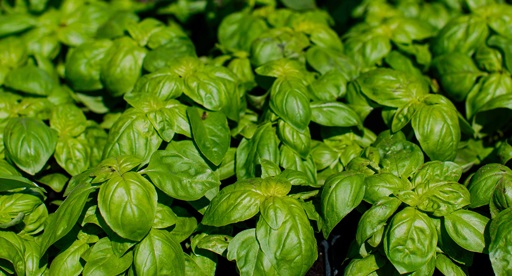
5 Steps to Basil Success
- Choose a sunny spot close to your kitchen for easy access. Basil is best planted in late spring, summer and autumn as it needs warmth.
- Prepare your soil well by digging in organic matter like compost and sheep pellets.
- Add a layer of herb mix to plant into.
- Feed basil regularly to promote green leafy growth.
- Water your basil consistently and pick regularly to help avoid it going to seed.
Follow our full guide below to a bumper crop of homegrown basil.
Fresh basil is one of summer garden’s best crops, and the sweet, fresh flavour it adds to a variety of dishes is hard to match. Basil is a mainstay aromatic culinary herb grown for its foliage. It features heavily in Italian cuisine, as well as many Asian dishes.
Prepare
Basil is a relatively quick herb to grow, available in a huge range of shapes, sizes, textures and flavours.
It can be a fussy herb as it dislikes wet feet, and also cold and damp weather. In warm areas, basil can be grown outside year-round, but it most parts of the country it’s a late spring, summer and autumn crop. A sunny windowsill is an ideal spot to grow basil in cooler areas, or a greenhouse if you have one.
Check out our Tui Basil Seed - Sweet Genovese for an aromatic herb with dark shiny leaves.
Refer to our Planting Calendar for when to plant basil in your region.
Plant
Like building a house a good foundation is the key to success in your garden. The better the soil, the better your plants will grow. If you are starting with an existing garden bed dig in organic matter like Tui Sheep Pellets and Tui Compost to your soil. Then you can add a layer of Tui Herb Mix. If planting in pots and containers, fill with Tui Herb Mix.
The best times to plant are early in the morning or late in the day, so the plants aren’t exposed to the hot sun straight away. Always water plants well before and after planting.
Don’t be shy when planting herbs as they quite like close neighbours, and you can always plant herbs in between other plants as they make great space fillers and companion plants.
Basil improves the flavour of tomatoes when planted alongside.
Planting in garden beds:
- Dig a hole, approximately twice the size of the root ball of your plant.
- Partly fill hole with Tui Herb Mix.
- Fill a bucket with water and add two capfuls of Tui Organic Seaweed Plant Tonic, a seaweed based plant tonic that promotes strong root growth and reduces transplant shock.
- Soak seedlings in the bucket of Tui Organic Seaweed Plant Tonic, ensuring they are fully submerged.
- Gently loosen the root ball of your plant and position the plant in the centre of the planting hole.
- Fill in with Tui Herb Mix.
- Press soil gently around the base of the plant.
- Water well.
Planting in pots and containers:
- If your container has no drainage holes, add stones to the bottom of the container to act as drainage.
- Partly fill your container with Tui Herb Mix. Tap the container gently on the ground to settle the mix.
- Fill a bucket with water and add two capfuls of Tui Organic Seaweed Plant Tonic. Soak seedlings in the bucket of Tui Organic Seaweed Plant Tonic, ensuring they are fully submerged.
- Gently loosen the root ball of your plant and position the plant in the container. Ensure the plant is sitting at the same level in the soil as it was in its seedling container.
- Fill in with Tui Herb Mix, up to 3cm from the top.
- Press soil gently around the base of the plant.
- Water your plant well.
Nourish
Feed your herb and they will feed you. Plants use nutrients from the soil as they grow, so replenishing the nutrients ensures your plants grow to their full potential.
Feed your herbs with Tui NovaTec® Premium fertiliser. Well-watered, well-nourished herbs will have a better chance of keeping insect pests and diseases at bay.
Over summer basil is prone to go to seed. To avoid, water your basil consistently, regularly pick, remove flowers and remove parts of the plant that go to seed. If your basil does go to seed there is an upside – the flowers are great for beneficial insects like bees, and if you let them fully dry out you can collect the seeds for next season!
- Jan
- Feb
- Mar
- Apr
- May
- Jun
- Jul
- Aug
- Sep
- Oct
- Nov
- Dec
- Harvest in 40-60 days